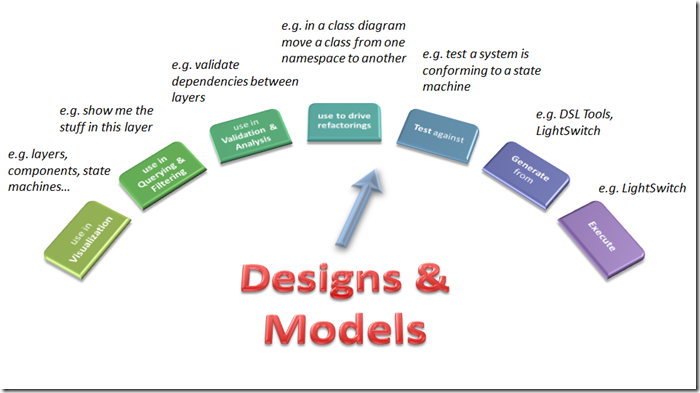Is Model Driven Development Feasible?
This is the question asked in the title of a post on our modeling and tools forum, and rather than answer directly there, I thought it would make more sense to post an answer here, as it’s then easier to cross-reference in the future.
The body of the post actually reads:
Various Microsoft attempts at MDD have failed or been put on the back burner: WhiteHorse, Software Factories, Oslo.
Does Microsoft have any strategy for Model Driven Development? Will any of the forementioned tools ever see the light of day?
First we need to clarify some definitions. I distinguish between the following:
Model-assisted development, where models are used to help with development but are not the prime artefacts – they don’t contribute in any direct way to the executing code. Examples would be verifying or validating code against models or even just using models to think through or communicate designs. UML is often used for the latter.
Model-driven development, where models are the prime artefacts, with large parts of the executing code generated from them. Custom, hand-written code is used to complete the functionality of the software, filling in those parts which are not represented in the model.
Model-centric development, where models are the prime artefacts, but interpreted directly by the runtime. Custom, hand-written code is used to complete the functionality, with an API provided to access model data and talk to the runtime as necessary.
These are not separated approaches, and development projects may use a combination of all three. In fact, I imagine a continuous dial that ranges from model-assisted development through to model-centric development, such as the one illustrated below (starting at the left, the first five tabs are examples of model-assisted development).
The challenge is to make the movement through the dial as seamless and integrated as possible, and also to make sure that these approaches can be adopted incrementally and in a way that integrates with mainstream development (agile) practices. Only then will we be able to unlock the potential productivity benefits of these approaches for the broader development community.
In Microsoft, there are a number of shipping products which support or employ one or more of these approaches.
In Visual Studio, we have DSL Tools and T4, which together support model-driven development. New functionality was added to both in VS2010, and T4, for template-based code generation, continues to see broader adoption, for example in the ASP .Net community as evidenced by this blog post. for example. Many customers use DSL Tools for their own internal projects, and we continually get questions on this forum and through other channels on this.
Visual Studio 2010 edition introduced a set of architecture tools: a set of UML Tools (built using DSL Tools), a tool for visualizing dependencies between code as graphs, and a tool for validating expected dependencies between different software components (layers). I would place all these tools under the category of model-assisted development, although the VS2010 feature pack 2 does provide some support for generating code from UML models, which allows these tools to be used for model-driven development, if MDD with UML is your thing.
Visual Studio LightSwitch combines a model-driven (generates code) and model-centric (directly interprets the model) approach to the development of business applications. It is a great example of how models can really make the developer more productive.
Outside of Visual Studio, the Dynamix line of products, also take a combined model-centric/model-driven approach to the domains of ERP and CRM business applications. For example, take a look at this blog post.
I am an architect with the Visual Studio Ultimate team, who are responsible for DSL Tools, T4, and the architecture tools. In that team, we are now looking into how to take these tools forward, focused very much on how to make software developers and testers more productive. Part of this will be to consolidate and integrate some of what we already have, as well as integrate better with other parts of Visual Studio and mainstream development practices. Another part will be to add new features and capabilities and target support on specific frameworks and domains – as LightSwitch does. We’re focused on addressing the challenge set out above, and to deliver value incrementally.
As we start to deliver the next wave of tools, I look forward to a continued conversation with our customers about the direction we’re headed.
Addendum (8/4/2011) : I forgot to mention that another problem we’re currently focused on is how deliver a much more seamless integration between models and code, which is essential to meet the challenge described above.
Comments
- Anonymous
April 16, 2011
Let's not forget ASP.NET Dynamic Data.
